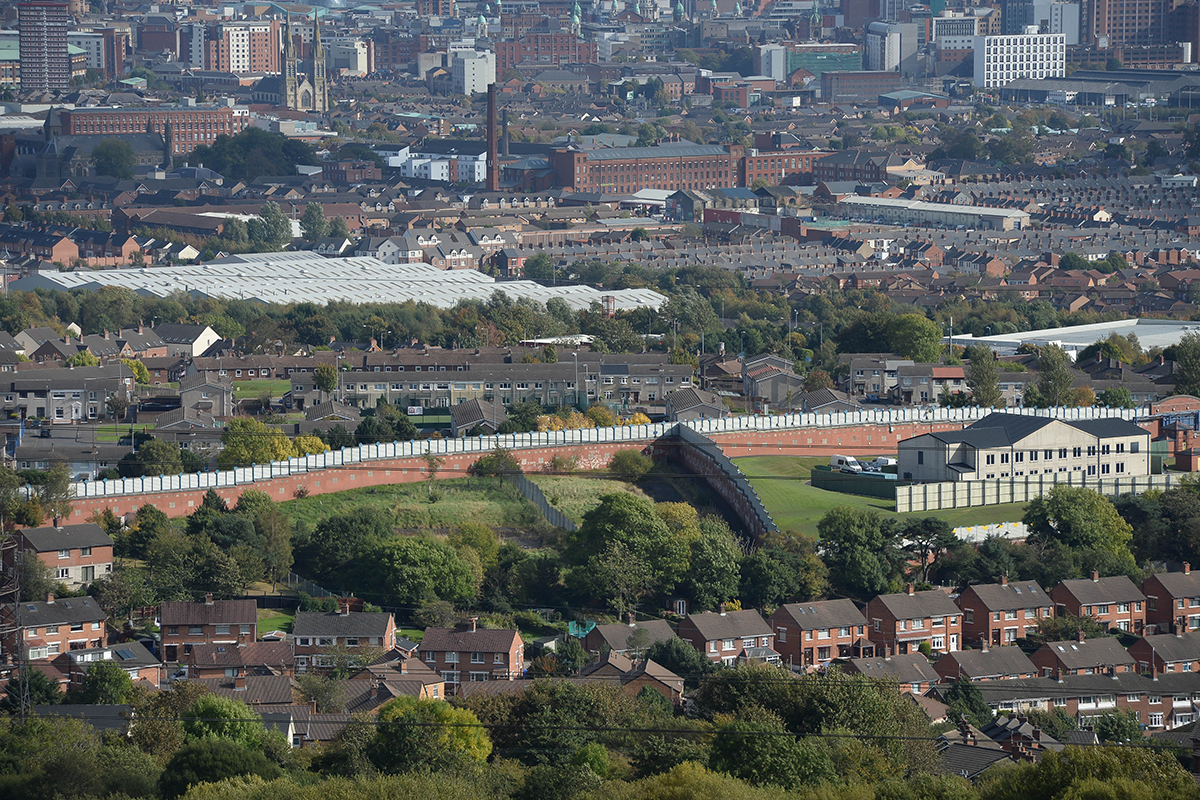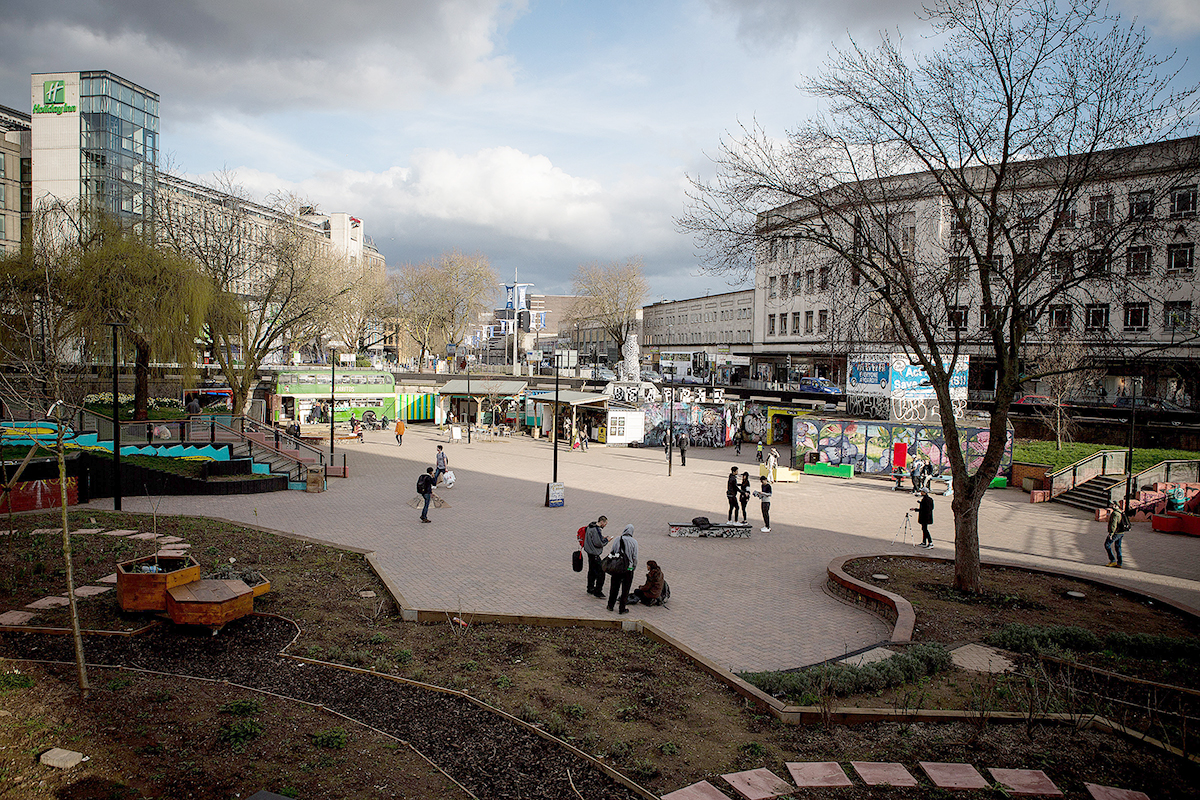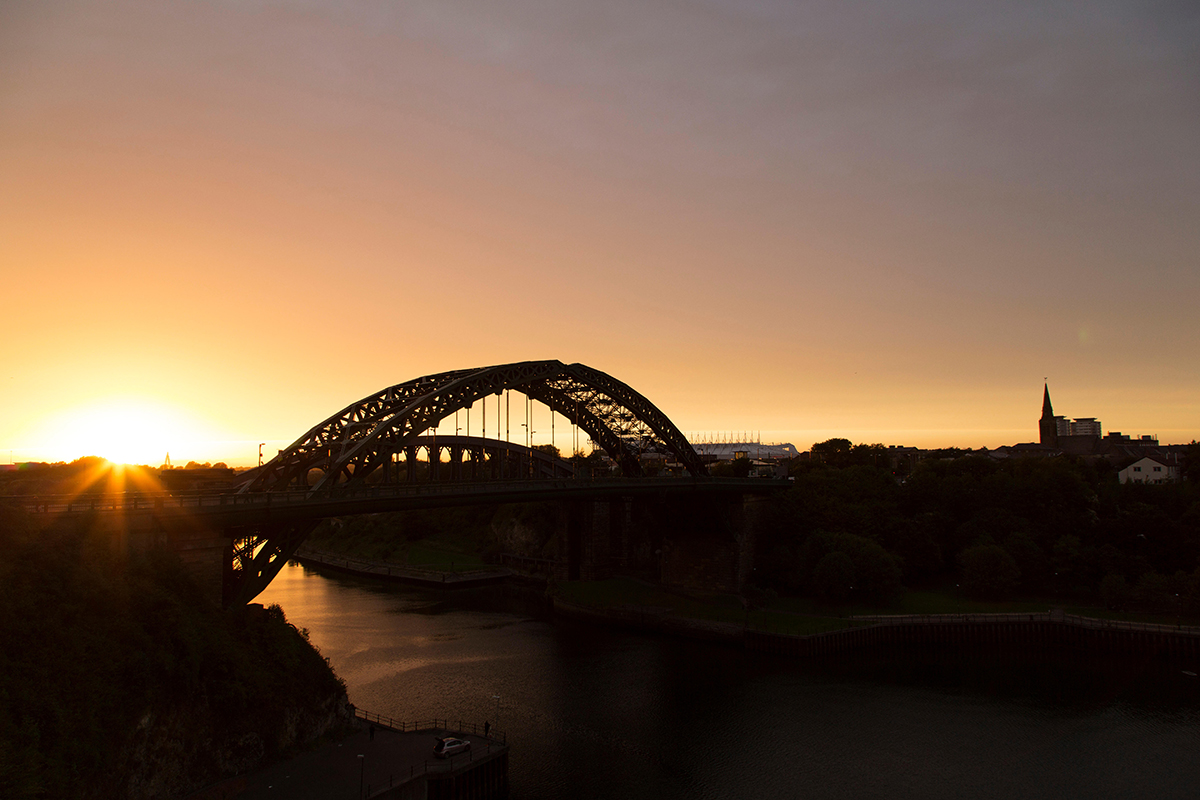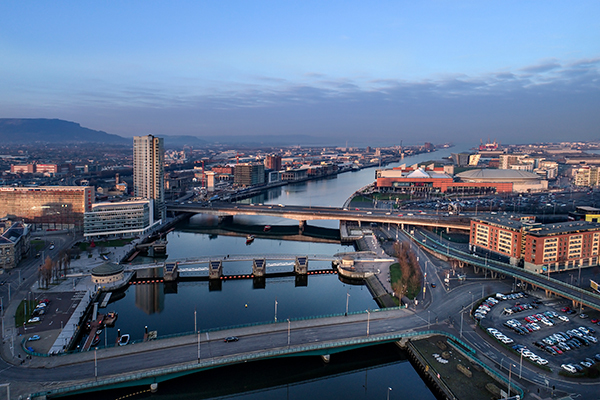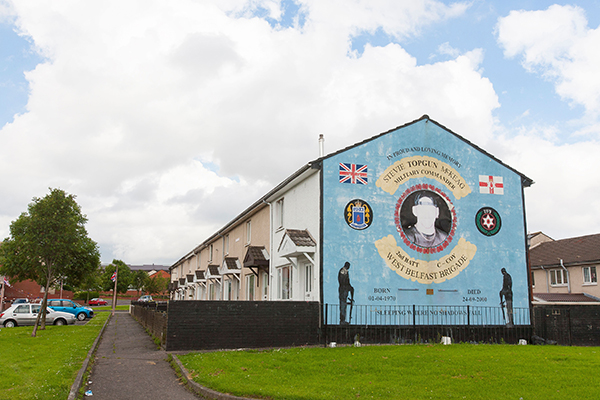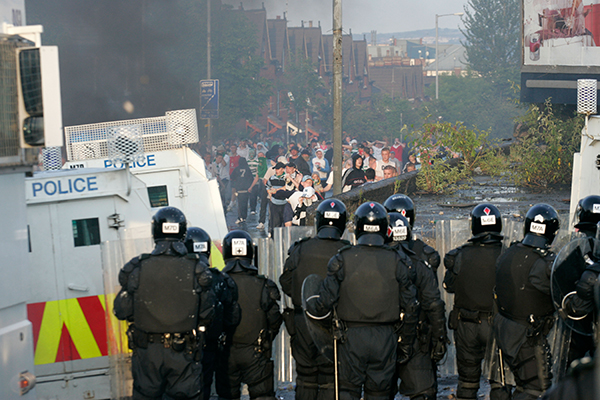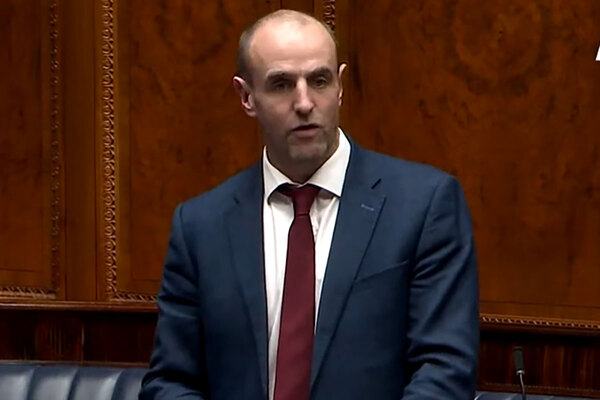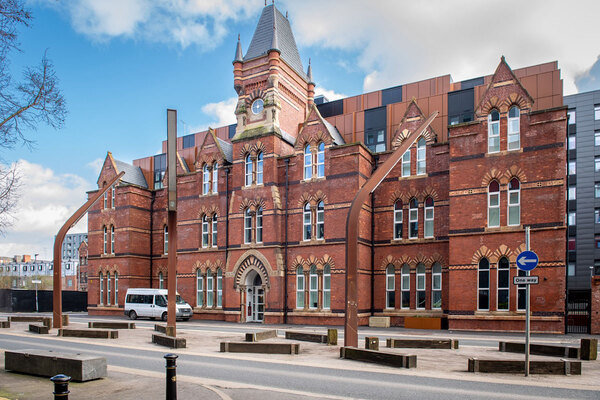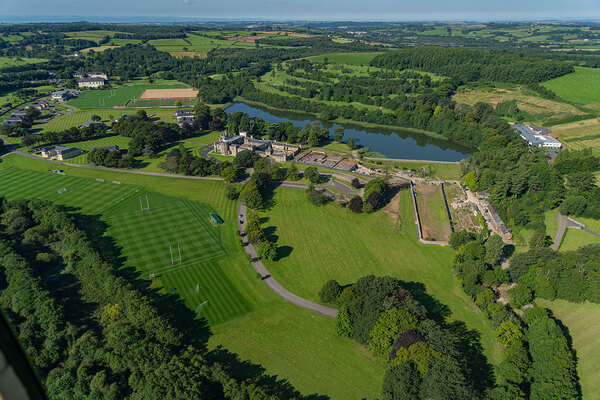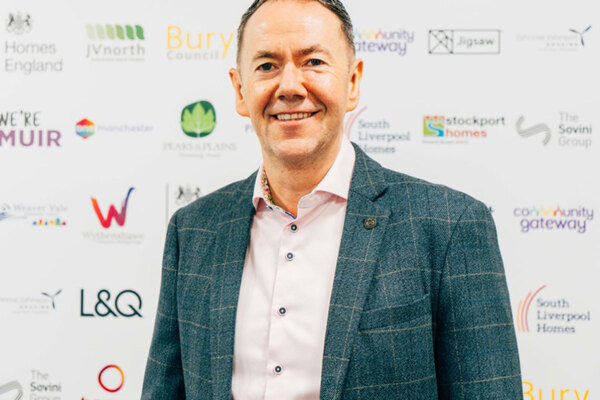You are viewing 1 of your 1 free articles
Healing the wounds: how social landlords are tackling segregation in Northern Ireland
Northern Ireland’s stark peace walls are visual reminders of the Troubles, and are still posing challenges for social landlords. Nathaniel Barker finds out more. Photography by Rex Features and Alamy
The 18ft-high peace line along Springmartin Road in Belfast, with a fortified police station at one end (centre right)
Perhaps the most visible reminders of the Troubles in Northern Ireland are the great looming structures known euphemistically as peace lines.
Around 100 of these giant metal walls divide unionists and nationalists across the region.
Many are found on social housing estates, posing huge problems for landlords – but, more importantly, both emblematising and perpetuating the segregation that still pervades working-class communities here. A vital part of the healing process lies with alleviating this division, and social landlords are acutely involved.
Housing was at the heart of the terrible conflict from which Northern Ireland is still recovering. The protests in Derry/Londonderry on 5 October 1968 that erupted into violence and are often marked as the day the Troubles began were largely about perceived discrimination against Catholics in the public housing allocations system.
And at the last census in 2011, on 90% of social housing estates in Northern Ireland at least four in five people were one of these groups or the other – that rises to 94% in Belfast.
“The social fallout from that segregation echoes and reverberates within our estates,” says Jennifer Hawthorne, head of communities at the Northern Ireland Housing Executive (NIHE).
This housing authority, established in 1971 to separate social housing from sectarianism and politics, was once the UK’s largest landlord with around 170,000 homes. Its stock has dwindled following a series of transfers to housing associations and the implementation of the Right to Buy, but it remains an 86,500-home behemoth. A fifth of peace walls across Northern Ireland are on its land.
Promoting good relations between religious groups has been a legal requirement of all statutory authorities in the region since the Good Friday Agreement. But, Ms Hawthorne adds, there’s more to it than that for the NIHE.
“We’ve been in these communities for more than 40 years. We know the effects of segregation and living with these walls. So we’re really committed as an organisation because we know our communities and we know that we can really effect a change with them.”
The walls present huge challenges to the NIHE as a social landlord too, brought into sharp focus by a trip through its estates in north Belfast. Take Bombay Street, a republican neighbourhood. The housing stock here is unusually new, with the whole street having been rebuilt after it was razed to the ground by a loyalist mob in August 1969.
High quality though the homes may be, the street is undeniably cramped. The small terraced houses are packed in together with barely any green space. That’s a reflection of the housing pressure experienced by Catholic households in north Belfast, where they make up 45% of the population but 75% of those in housing stress on the waiting list.
And all the while, one of the peace walls looms over them – a huge army-green partition. Some of the houses are literally armoured to protect against missiles being cast over it. This wall creates a physical barrier preventing further development. New social homes are urgently needed to tackle the area’s rising homelessness – but there is nowhere for them to go.
A mural in Belfast commemorates Stevie McKeag, commander of a west Belfast paramilitary group during the Troubles
A report by the Equality Commission for Northern Ireland in June found Catholics still wait six months longer than Protestants for social housing on average. Pass through the spiked gates to the other side of the wall – which will be shut by police after 6.30pm – and it is easy to see why. On the unionist side, the homes have front gardens. The streets are noticeably wider, the buildings sparser. There are large grassy areas in between, frequently used by locals to build dangerously tall bonfires.
But here too, development is suffocated; not by lack of land, but by market forces. Belfast’s Protestant population has been steadily declining for some 20 years – meaning social housing demand in these areas is extremely low compared with the other side of the wall. Here, a new home’s value would barely cover the cost of construction, while its price in a republican area would be nearly twice as high.
“In effect you have two housing markets. You end up with paradoxes. Some areas have a very high demand for land but nowhere to build, while in others there is plenty of land but no demand,” explains Duncan Morrow, a leading academic in sectarian segregation in Northern Ireland based at Ulster University. “And both sides suffer because of it.”
It’s a huge housing management headache, putting some of the issues faced by social landlords across the rest of the UK into perspective. And sectarianism causes the NIHE problems in many other ways, too.
“Walls are a physical manifestation of serious conflict within that area.” - Jennifer Hawthorne, head of communities, Northern Ireland Housing Executive
For instance, a loyalist mural appears on a house on one of its estates in the once-notorious Shankill area of west Belfast. It is a tribute to the late Stevie McKeag. Nicknamed ‘Top Gun’, he was a commander of one of Northern Ireland’s most violent paramilitary groups, a terrorist who the Royal Ulster Constabulary associated with at least a dozen murders. The NIHE has come under fierce criticism for its failure to take the mural down, but there is little to be done; the house has been sold under the Right to Buy, and so it has no power to remove it.
Through its Building Relations in Communities programme, the NIHE is doing its best to ease sectarian tensions on its estates. The programme costs about £1m a year all in, with the money drawn from various sources.
There are huge challenges. The first lies within the people living next to the walls.
“Those walls are a physical manifestation of serious community conflict within that area,” says Ms Hawthorne. “So you have that memory within those residents – many who have been there for 20 to 30 years and whose thought when you suggest the removal of the peace wall is: ‘But my next-door neighbour was shot dead, how are you going to protect me and make sure I’m not going to get attacked?’ Those are real fears.”
A mural relating to the Troubles on Bombay Street
Second, paramilitary groups are still present on some social housing estates. It is not unusual for smaller housing associations in Northern Ireland to require external help to manage terrorist influence across their communities.
“They set the permissive environment for what is allowed and what is not allowed,” says Mr Morrow. “They are extremely feared.”
The third lies with the political class, he posits. “The political leadership is deeply ambivalent and in my view that results in half-hearted policies. We are now 20 years on since the Good Friday Agreement, yet we have not ever had a systematic policy to address the issue of segregation in social housing.
“They have different reasons for their ambivalence, but broadly speaking the political parties find it easier to organise on a territorial basis.”
So it’s not surprising that the NIHE chooses a softly-softly approach to desegregation. Its community relations officers identify areas which might be open to integration and start conversations. Much of the work involves what the NIHE calls “re-imaging” – the removal of gauze from a tenant’s windows or the installation of a new sculpture. In the case of the estate with the McKeag mural, it means creating a new mural across the road which simply reads “Love”.
“The big thing for us is we can’t go and do it to them. We’ve got this aim, we’ve got a strategy, the community cohesion strategy,” Ms Hawthorne stresses. “But in reality we have to work on the ground and at the pace of the community.”
Painstaking though all this appears, it has yielded results. In February 2016, following three years of engagement with the local communities, a peace wall on the Crumlin Road in the Ardoyne area of Belfast was demolished. It was a huge symbolic victory for what was once the most contested land in Northern Ireland – with 1,000 people killed within one mile over the course of the Troubles. Ms Hawthorne’s team is now working to bring down a second wall in the same area, just a few hundred yards from where a young police officer was shot in early 2017 by a group calling itself the ‘New IRA’.
New build makes up the other half of the desegregation strategy. The NIHE allocated grant for housing associations to build 11 shared housing schemes starting in the mid-2000s, and has since overseen development of a further 10 through the Northern Ireland Assembly’s Together: Building a United Community (TBUC) strategy, introduced in 2013. Note here that in Northern Ireland, “shared housing” means simply sites occupied by both Catholics and Protestants, as opposed to the definition generally recognised in England, Scotland and Wales.
Riot police face rioters on Crumlin Road, Ardoyne, on 12 July 2005
Such projects are not easy in reality. Clanmil, a 4,500-home housing association, has a 97-unit TBUC scheme in north Belfast which was fully handed over in December 2017. The landlord is currently engaged in a series of community-building initiatives, from helping establish a tenants’ association to organising public art exhibitions.
“This is work that takes time and a lot of work to achieve,” explains Colette Moore, director of housing at Clanmil. “There isn’t any blueprint for this kind of work.”
Ms Moore says that, so far, the area of Felden is a success story, but adds there have been challenges. During construction, false rumours that quotas would be used to allocate the homes gathered traction and led to graffiti threatening Clanmil staff being scrawled on a wall on the estate.
“We had to spend a lot of time and energy engaging with the community and explain that is not going to happen,” recalls Ms Moore. “The lesson for us as a housing provider is we can’t do it all alone. We felt we had to take it all on our shoulders but we have to bring in other public agencies – that is absolutely crucial.”
In September last year, four Catholic families at a scheme in south Belfast owned by Fold, part of 12,000-home association Radius, were forced to flee their homes after receiving sectarian threats from suspected paramilitary groups.
In any case, the fact that these schemes exist at all represents progress which would scarcely have been thinkable 20 years ago. And Ms Hawthorne is convinced that the NIHE’s work – together with organic demographic shifts in the region – has made an impact. She reveals that updated segregation figures finalised towards the end of 2017 show that “there appears to have been a significant reduction in segregation”. Frustratingly, these figures require ministerial sign-off before publication and so cannot be released until a government is restored at Stormont.
Doubtless there is a long way still to go. But the story of desegregation work in Northern Ireland’s social housing estates sends a message to landlords across the UK.
“Dogged persistence; don’t give up,” says Ms Hawthorne. “Because our first peace wall – that took three years [to remove]. That started with a public meeting where under no circumstances was there anybody willing to have a peace wall removed.
“So I would say stick at it. If it’s the right thing to do, it will happen.”
